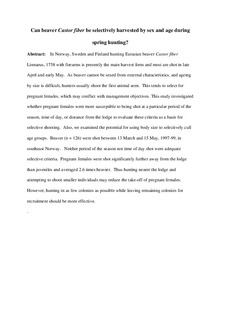Can beaver Castor fiber be selectively harvested by sex and age during spring hunting?
Conference report
Permanent lenke
http://hdl.handle.net/11250/2438011Utgivelsesdato
2000Metadata
Vis full innførselSamlinger
Originalversjon
Conference paper. 2nd European Beaver Symposium, 27-30 Sept. 2000, Białowieża, PolandSammendrag
In Norway, Sweden and Finland hunting Eurasian beaver Castor fiber Linnaeus, 1758 with firearms is presently the main harvest form and most are shot in late April and early May. As beaver cannot be sexed from external characteristics, and ageing by size is difficult, hunters usually shoot the first animal seen. This tends to select for pregnant females, which may conflict with management objectives. This study investigated whether pregnant females were more susceptible to being shot at a particular period of the season, time of day, or distance from the lodge to evaluate these criteria as a basis for selective shooting. Also, we examined the potential for using body size to selectively cull age groups. Beaver (n = 126) were shot between 13 March and 15 May, 1997-99, in southeast Norway. Neither period of the season nor time of day shot were adequate selective criteria. Pregnant females were shot significantly further away from the lodge than juveniles and averaged 2.6 times heavier. Thus hunting nearer the lodge and attempting to shoot smaller individuals may reduce the take-off of pregnant females. However, hunting in as few colonies as possible while leaving remaining colonies for recruitment should be more effective.
